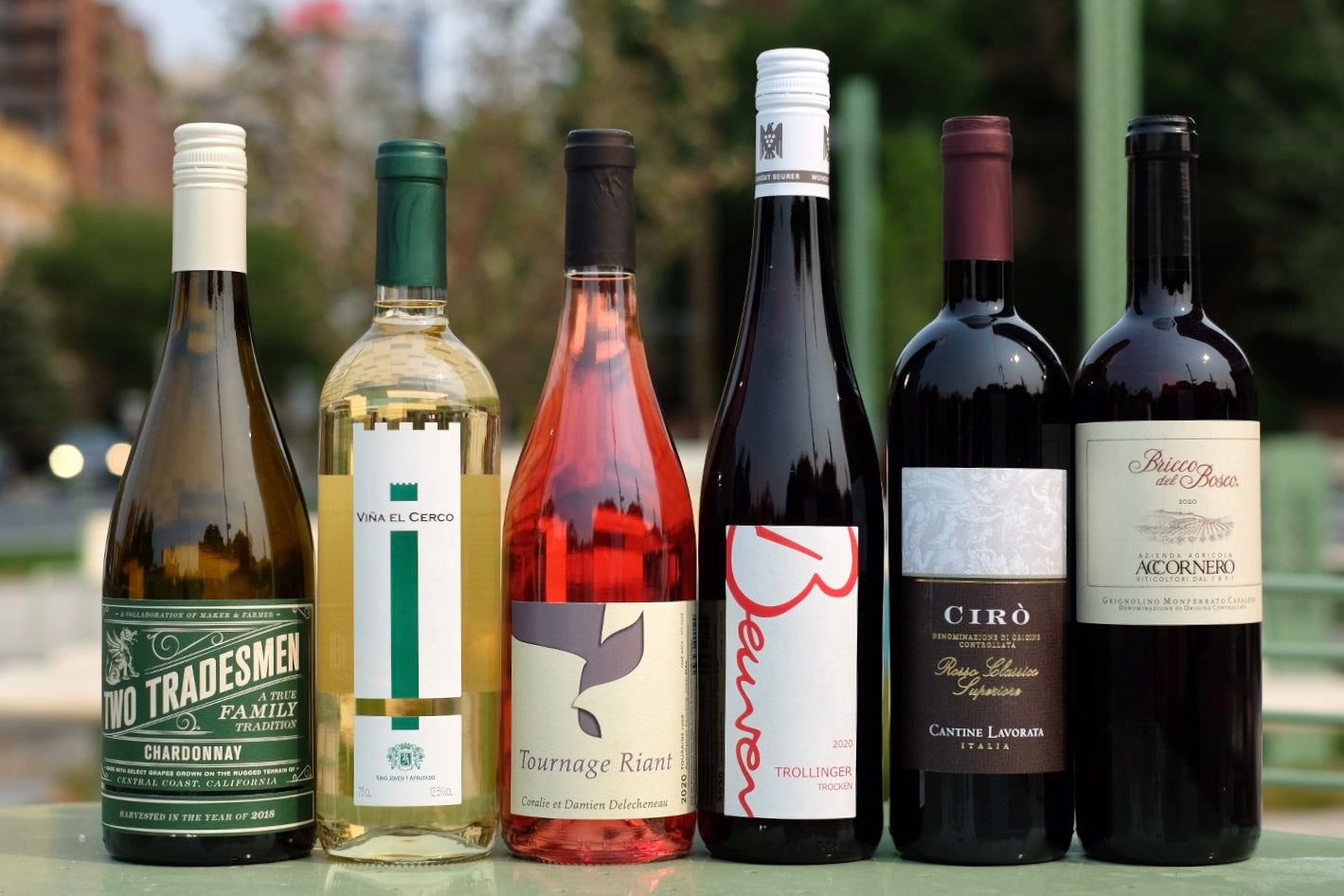| Hello everyone, the August edition of Vine Arts Wine Club is here. This month's wine bag includes some traditional grape varieties that are seeing resurging interest in their home regions - Grignolino from Monferrato, Gaglioppo from Calabria, and Trollinger from Baden-Württemberg. Throw in a crisp Airén from Navarre, a classic Chardonnay from northern California, and a juicy rosé from the Loire Valley, and you've got a tasty selection of wines. Your wine bags will be available for pickup Sunday, August 1st. We hope you enjoy! |
| 2018 Two Tradesmen Chardonnay Central Coast/California, United States $23.60 | Where The Central Coast appellation extends some 450 kilometres from Contra Costa County to the Santa Ynez Valley. Within its borders are 40 sub-AVA’S, including Paso Robles, Santa Cruz Mountains, Monterey, and Santa Barbara. In a state that is seeing warmer vintages, the Central Coast's proximity to the cool waters of the Pacific Ocean is hugely important. Gaps in coastal ranges allow cool breezes from the ocean to funnel into the vineyards. Further inland the Central Coast receives significant sunshine and warmth. What California is world renowned for its rich and fruit-driven Chardonnay’s. Achieving peak success during the 1980’s, today it’s still the state’s most widely planted white grape variety. Malleable and versatile, it is easily shaped by the winemaker's hand. Styles range from bone-dry and sharply acidic, to voluptuously fruity and buttery. Grape growers like Chardonnay for its adaptability in the vineyard and ability to produce high yields. In California the only major challenge with Chardonnay is maintaining its natural acidity. The grapes for this wine were harvested from Paragon Vineyard in Edna Valley. Situated at the southwestern corner of San Luis Obispo County, this area has a cooler climate than other areas within the Central Coast appellation. It also has one of the longest growing seasons in California, ideal for growing Chardonnay and Pinot Noir. Avoiding too much oak influence, this Chardonnay spent only 3 months in neutral oak barrels. Who This Chardonnay was created in partnership with winemaker McPrice (Mac) Myers, who makes the Two Tradesmen wines out of a crush pad winery in Paso Robles. A crush pad winery is an incubator for winemakers, allowing them to produce wines without having to worry about the overhead of owning their own facilities. Producing wines for two decades, Myers showcases the many unique terroirs of the Central Coast. Interestingly he first caught the wine bug while working at a Trader Joe's. Since making his first wines in 2002, he has developed a following for the wines that he produces at his namesake winery. Taste In the glass this Central Coast Chardonnay is medium gold in colour. The nose leads with aromas of baked apples, yellow pears, and ginger, followed by a savoury scent of vanilla. The palate is medium bodied with a rich mouthfeel. There are ripe flavours of pineapple, red apple, and mango yoghurt. On the finish you find a drop of baking spice sweetness. We suggest giving this wine 5 to 10 minutes out of the fridge to reach the best service temperature. A wonderful match for buttery popcorn, it is also a great pairing for decadent lobster rolls. |
| NV Bodegas Artajona Viña El Cerco Blanco Navarre, Spain $24.23 | Where Bodegas Artajona is located in the northern Spanish region of Navarre. A broad appellation where grapevines have been tended since the Romans, there are around 12,000 hectares of vineyards in Navarre today. Diverse with a range of microclimates and soil types, there are five recognized subregions: ‘Baja Montaña’, ‘Tierra Estella’, ‘Valdizarbe’, ‘Ribera Alta’, and ‘Ribera Baja’. The dual influences of the Bay of Biscay and the snow capped Pyrenees mountains moderate Navarre’s generally Mediterranean climate. What The Viña El Cerco Blanco is made from Spain’s most widely planted grape variety, Airén. Indegenous to the Iberian Peninsula, there are an estimated 252,000 hectares of Airén planted in the world. This is down from a high of 306,000 hectares during the early 2000’s, when Airén was the most planted grape in the world. A hardy variety well suited to arid wine regions, it is typically planted at low density. This low maintenance white variety is often vinified and matured in stainless steel tanks to maintain freshness. In addition to still wines, Airén is widely used for the production of Spanish Brandy. Who Bodegas Artajona was started in 1957 by the Pérez de Ciriza family. Originally from the town of Artajona, the family decided to move to Pamplona in order to open a winery. Still run by the same family, the business has expanded to include four wineries - Bodegas Artajona, Bodegas Olimpia, Pagos de Obanos, and Bodegas Cialu. The wines of Bodegas Artajona are made from grapes grown around Artajona. The area benefits from a mild climate where warm days are followed by cool nights. The primary soil type is calcareous clay. In 2002 the family inaugurated a thoroughly modern winemaking facility. Today led by Pablo Javier Pérez de Ciriza, Bodegas Artajona produces wines under the Navarra and the Vino de la tierra designations. Taste The Bodegas Artajona Viña El Cerco Blanco is a crisp and refreshing everyday white wine. Pale gold in hue, it reveals aromas of fresh yellow apples, citrus zest, grapefruit, and banana. On the palate it is light bodied with brisk acidity and fruity flavours. We suggest serving this Airén well chilled. Enjoy it on its own or with light fare and seafood. |
| 2020 Coralie & Damien Delecheneau La Grange Tiphaine Tournage Riant Rosé Touraine, France $26.58 | Where The appellation of Touraine lies southwest of the French capital in the center of the Loire River Valley. Known as the “Garden of France”, the Loire is one of the most charming areas of France. The gentle landscape is dotted with renaissance châteaux and atmospheric medieval villages. The vineyards are planted close to the Loire, France’s longest river. The Touraine appellation follows the river some 100 kilometres, from Blois in the east to Chinon in the west. Situated 225 km from the Atlantic coast, the climate is mostly continental with maritime influences. Touraine’s finest vineyards have been planted in areas where the soil is free-draining and rich in tuffeau. A calcareous rock, tuffeau is bleached white in appearance and was used to build Touraine’s stunning country homes. The quarries that were dug to extract the stone are today used by Touraine’s winemakers as naturally cool wine caves. What The ‘Tournage Riant’ rosé is made from a cépage of Côt (Malbec), Gamay and Grolleau. Less known than the other two grape varieties in this blend, Grolleau is one of the Loire Valley's workhorse grapes. Because of its vibrant colour, subtle character, and thin skins, it’s most commonly used to produce rosé wines. Grolleau is named for the French word “grolle”, which means "crow", and refers to the variety’s concentrated colour. The grapes were hand harvested and gently direct-pressed. A saignée (“to bleed”) method rosé, the light cherry colour came from short maceration with the skins. Once vinified, the wine was aged for 5 months in a concrete tank. Who The history of La Grange Tiphaine goes back to the 19th century and Alfonse Delecheneau. Passed down through three generations, today the business is managed by Damien Delecheneau. Damien studied oenology and viticulture in Bordeaux, and worked at wineries in California and South Africa. Today he organically farms 15 hectares of vines in the regions of Touraine Amboise and Montlouis sur Loire, where Damien has been the president of the appellation since 2016. The La Grange Tiphaine is Damien’s négoce wine label, which includes wines made from organically farmed grapes purchased from neighbouring growers. Taste In the glass the La Grange Tiphaine Tournage Riant rosé is pale cherry in hue. It’s deeper colour is divergent from the style of rosé that has become ubiquitous to southern France. On the nose it has fruit-forward aromas of fully ripened strawberries, wild red raspberries, rose water, and lemon drop. The medium bodied palate is complemented by crunchy acidity and a dry finish. This is a style of rosé for those looking for something with a little more weight and concentration. For best results, allow 15 minutes out of the fridge for ideal service temperature. It’s a great match for warmed traditional fouée (a round, airy bread) served with country pork rillettes, and mogettes (white beans). |
| 2020 Beurer Trollinger Baden-Württemberg, Germany $27.68 | Where Baden is Germany’s most southern wine region, and the warmest growing area in the country. It is also third in terms of land under vine. The appellation forms a large “L”, following the course of the Rhine river. Situated just east of Baden, Württemberg is Germany’s fourth largest wine region. Together Baden and Wurttemberg cover a large expanse of southwestern Germany. Unsurprising given their expansive size, there is wide-ranging diversity in soils and microclimates. Overall the climate is mostly sunny and dry. The political state of Baden-Württemberg is Germany’s third-largest state by both area and population. What Unlike the Mosel Valley or Rheingau, Baden and Württemberg are best known for red wines. Thanks to the warm and sunny climate, red grape varieties can reliably ripen every year. In Baden the most dominant grape variety is Spätburgunder (aka Pinot Noir), where the most dominant red variety’s in Württemberg are Lemberger and Trollinger. Trollinger is originally from the Italian wine region of Alto Adige, where it is known as Schiava. Late-ripening and fragrant, in the past the variety was commonly employed to produce fruity, easy drinking wines akin to Beaujolais. As plantings have declined, winemakers have been exploring Trollinger’s more complex qualities. Still light and refreshing, these wines are sleek with finely textured tannins. Who This small Swabian winery was created by former European BMX champion Jochen Beurer. The Beurer’s have cultivated vines near Stuttgart for generations, selling their grapes to the local wine cooperative. In 1997 Jochen, his wife Marion, and his father Sigfried started making wines for themselves. For the first two years the winery was literally just a garage. As things developed the decision was made to transition to organic farming. This eventually made way for the introduction of biodynamic farming principles, which have yielded impressive results. Jochen’s respect for nature is evident in the quality of his grapes. During the harvest he will patiently make multiple passes to ensure optimal grape ripeness. Using only natural yeasts for fermentation, Jochen will age his wines slowly until the time feels right. Taste Pale in colour, the Beurer Trollinger has fragrant aromas of sour red cherries, strawberries, and pomegranate. Glossy and polished tannins are complemented by crunchy, linear acidity. Mouthwatering and youthful, this wine is a delightful summer thirst quencher. Serve it with a slight chill for optimal deliciousness. This is our go-to taco pairing for Summer 2021. |
| 2018 Cantine Lavorata Cirò Rosso Classico Superiore Calabria, Italy $24.66 | Where Cantine Lavorata is located in Roccella Ionica, a picturesque little town in the Province of Reggio Calabria. The southernmost part of mainland Italy, this region is the “toe” of the Italian “boot”. Known as “the land between two seas”, it is surrounded by the Ionian and Tyrrhenian Seas, whose waters serve to moderate temperatures. To the north Calabria shares a border with Basilicata. This is one of Italy’s most rural areas. Much of the landscape is underdeveloped and mountainous. The region's 12 designated wine zones are diminutive in size and concentrated near the coast. Rather than grape vines, most of Calabria’s arable agricultural land is planted to cereals, citrus, and olive trees. What The Lavorata Cirò Rosso Classico Superiore is made from 100% Gaglioppo, a rare grape variety grown primarily in Calabria. Once thought to be of Greek origin, a 2008 study showed that Gaglioppo is in fact a crossing of Sangiovese and another unidentified grape variety. The variety has been grown by grape growers in Calabria for thousands of years. The grapes for this wine were grown in the subregion of Cirò. Located in the eastern foothills of the La Sila plateau, the vineyards face the glimmering waters of the Ionian Sea. Red wines from this area are typically full bodied with plenty of tannic structure. The grapes were harvested in October and fermented in stainless steel tanks. Once vinified, the wine was aged for 12 months in chestnut barrels. Prior to bottling, the wine spent another year in stainless steel tanks to settle. Who Cantine Lavorata was created in 1958 by Ilario Lavorata, whose family had been growing grapes since the mid-1800’s. Before this Illario had worked in Milan, but he felt the draw to return to his hometown of Roccella Ionica to produce wines using Calabria’s indenegous grape varieties. Today the business is still family run, and is managed by Domenico, Danilo and Adele. The bulk of the vineyards are planted to Greco Nero, Greco Bianco and Gaglioppo, and are located in the contrada of Nescilacqua in Riace, an area made famous for two Greek bronze warrior statues that were found here in 1972. Taste Made from the flagship grape variety of Calbaria, the Cantine Lavorata Cirò Rosso Classico Superiore is a robust and flavourful red wine. Deep garnet in colour, on the nose it has aromas of ripe black cherries, licorice, balsamic, and rosemary. The palate is full bodied with blackfruit flavours and dense tannins. The finish is dry with lingering bitterness. Try it with Calabria’s famous cured meats, Calabarese Salame and spreadable Nduja. |
| 2020 Azienda Agricola Accornero Bricco del Bosco Grignolino del Monferrato Casalese Piedmont, Italy $29.30 | Where The Grignolino del Monferrato Casalese wine appellation is located in the southeast corner of Piedmont. The DOC was created 1994 as a subregion within the larger Monferrato DOC. Lying south of the Po river and crossed by the river Tanaro, Monferrato has been home to grape growing for centuries. The northern section, Basso Monferrato, is an area with hills and plains. The southern section, Alto Monferrato, climbs upwards towards the Apennine mountains. In the center lies a third section, Monferrato Astigiano. The area has a rolling landscape and is home to numerous historic towns. The continental climate brings hot summers and cold winters. What Grignolino is a red grape variety that is traditionally grown in Monferrato. The name of the grape comes from the local word for seeds, grignole. The varieties' high concentration of bitter seeds make it a difficult grape to make wine with. Although Monferrato’s Grignolino wines have had their own DOC for over 20 years, the wines are still under-appreciated. The typical Grignolino del Monferrato Casalese is light to medium bodied, with high acidity and firm tannins. It’s an everyday grape akin to Dolcetto. The Accornero Bricco del Bosco Grignolino del Monferrato Casalese is made from 100% Grignolino harvested from vines planted at 216 meters in elevation. The wine was traditionally vinified with gentle pumping over of the must and spontaneous malocation fermentation (the conversion of malic acids to lactic acids). Ageing was in stainless steel tanks. Who Established in 1897, Azienda Agricola Accornero is managed by Ermanno Accornero. The winery goes back to Bartolomeo Accornero, who purchased the Cà Cima farmhouse from a noble family. Passed down through the generations, in the 1950’s the estate was controlled by Ermanno’s father, Giulio. At this time there were only 5 hectares of vines and the wines were mostly sold in bulk, with only a small number of bottles sold to loyal customers. Giulio’s two sons, Massimo and Ermanno, started taking part in running the winery by the end of the 1970s and early 1980s, and focused on estate bottling. Today Ermanno farms 25 hectares of vineyards planted to Malvasia di Casorz, Barbera, Freisa and Grignolino. He is assisted by consultant winemaker Mario Ronco, who also works with other wineries in the area. Taste Medium garnet in colour, the Bricco del Bosco Grignolino has lifted aromas of fresh wild red berries, rhubarb, wild flowers and mint. The palate is medium bodied with compact tannins, lean acidity and bitter cherry flavours. On the finish it is dry and lasting. We suggest pairing it with finely formed agnolotti del plin. These tender, bite-sized pillows of pasta can be stuffed with either creamy cheese, meat, or vegetable filling. |


